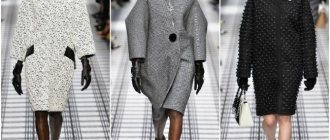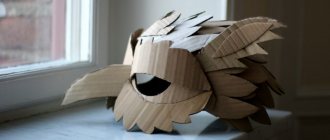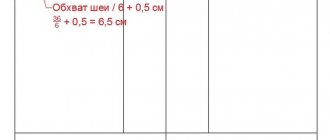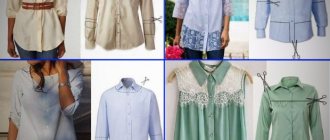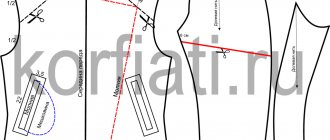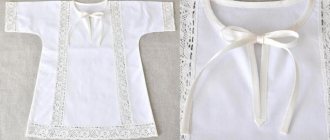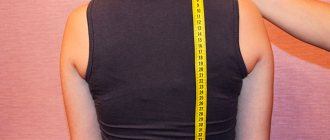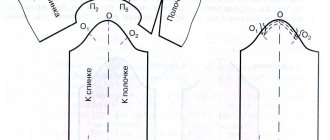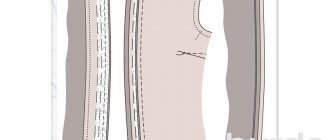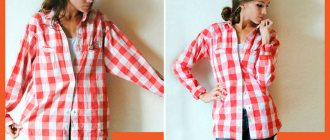Sewing a shirt for a boy with your own hands is not that difficult; all you need to do is have a pattern and a detailed description with step-by-step photos on hand. All you have to do is stock up on fabric, and you will find everything else in this article. We have already learned how to sew the simplest things - blouses and pants, now it’s time to move on to a more complex product.
The article offers several patterns for children's shirts for different ages and sizes. Patterns also differ in the presence of short or long sleeves. However, in general they are very similar, so the sewing process is identical for everyone. In order not to duplicate the assembly description, at the very end of the article there is a detailed master class that can be applied to any of the presented patterns. Let's start with the smallest ones.
How to sew a shirt for a boy - a simple pattern of a classic model!
A classic men's shirt should be in every young gentleman's wardrobe. Sew such a shirt for your boy and he will be the most stylish among his peers! Our step-by-step instructions will help you create a shirt pattern.
Pattern modeling
To begin construction, you need to take measurements (measurements of size 36 are used in construction). See: How to take children's measurements
To create a shirt pattern for a boy, you need to take the following measurements:
- Chest circumference (OG) – 73 cm
- Neck circumference (NS) – 31.5 cm
- Shoulder length (L) – 10 cm
- Armhole depth (Gpr) 17 cm
- Armhole width (Shpr) 8.5 cm
- Shoulder circumference (OP) 24 cm
- Wrist circumference (OZ) 16 cm
- Sleeve length (DR) 52 cm
- Shirt back length (DI) 60-65 cm.
Creating a drawing grid
Draw a rectangle ABCD.
Shirt length. The lines of the rectangle AN and BH1 are equal to the length of the shirt according to measurement = 65 cm.
Boy's shirt width. AD = BC = Half chest circumference according to measurement + 4.5 cm for all sizes (increase for loose fit from Table 1): 73/2 + 4.5 = 41 cm. The amount of increase can be increased or decreased depending on the size and desired silhouette of the product.
Armhole depth. From point A downwards, set down the armhole depth measurement + 1.5 cm for loose fit from Table. 1: AG = 17 cm + 1.5 cm = 18.5 cm. From point G to the right, draw a straight line until it intersects with line BH1 - point G1 is obtained.
Shirt side line. From point G to the right, set aside ½ GG1 - point G2. From point G2 down, draw a vertical line until it intersects with the line HH1 - point H2 is obtained.
Armhole width. Armhole width = Armhole width according to measurement + 2 cm (addition for freedom of fit from Table 1): 8.5 cm + 2 cm = 10.5 cm. From point G2 to the left and right, set aside G2G3 = G2G4 = 5.25 cm ( 1/2 the width of the armhole). From points G3 and G4 upward, draw vertical lines until they intersect with line AB - points P and P1 are obtained.
Construction of the back of the shirt
Neckline. From point A to the right, set aside AA1 = 1/6 Neck circumference according to measurement + 1 cm (for all sizes) = 31.5/6 + 0.5 cm = 6.25 cm. From point A1 up, set aside A1A2 = 1.5 cm Connect point A to point A2 with a concave line.
Back shoulder line. From point P down, set aside 2 cm. From point A2 through point 2 (shoulder slope), draw a shoulder line with a length of A2P2 = 10 cm + 1.5 cm = 11.5 cm (shoulder length according to measurement + 1.5 cm for all sizes) .
Back armhole line. From point G3, dividing the angle in half, set aside 2 cm. Draw the armhole line from point P2 through the middle point PG3, point 2 to point G2.
Bottom line of the back. From point H2 up, set aside H2H3 = 2 cm. Draw a curly line for the bottom of the back along the pattern.
Back yoke. From point A, set aside 6 cm downwards. From point 6 to the right, draw a horizontal line until it intersects with the back armhole line. From the intersection point up along the armhole line, set aside 1 cm and connect point 1 with a smooth line to the yoke line. Cut the back yoke and cut it out with a fold along the middle line of the back.
Fold allowance. Along the middle line of the back, set aside 4 cm to the left and draw a fold allowance from the yoke line to the bottom of the back.
Building a shelf
Shelf neckline cutout . From point B, draw an arc with radius R = BB1 = BB2 = 1/6 Neck circumference + 1 cm (for all sizes) = 31.5/6 + 1 cm = 6.25 cm.
The slope of the shoulder of the shirt front. From point P1, set aside 2 cm downwards. Draw a shelf shoulder line from point B1 (neck) through point 2 with a length of B1P3 = 11.5 cm (shoulder length according to measurement + 1.5 cm).
Armhole line. From point G4, dividing the angle in half, set aside 2 cm. Draw the armhole line through points P3, the middle point of dividing the segment P1G4, through point 2 to point G4.
Bottom line of shirt front. From point H2, set H2H3 = 2 cm up. Draw a curved line for the bottom.
One-piece shirt placket. Along the mid-front line from points B2 and H1, add 1.5 cm to the right for the width of the strap and 3 cm for processing the strap (4.5 cm in total), draw two vertical lines parallel to the mid-front line.
Rice. 1. Pattern of a shirt for a boy - back and front
Stand collar pattern
To create a stand-up collar pattern, measure the length of the neckline according to the shirt pattern along with the placket (without allowance for processing the placket). Set aside 1/2 of the length of the measured value: AB = DC = Neck length according to the drawing (Fig. 1). The height of the rectangle AD = BC = 10.5 cm.
From point C, move 1 cm up and 0.5 cm to the right. Construct the configuration of the post and the flyaway collar as shown in Fig. 2. Cut the stand and cut it separately from the flyaway collar.
Rice. 2. Pattern of a stand-up collar for a boy’s shirt
Next, proceed to constructing the sleeve and cuff patterns
See also:
- Boy's trouser pattern
- Jacket pattern for girls
- Coat pattern for girls
- Carnival costume
Related materials:
102 comments
Cutting out the parts
A pattern for a boy's shirt is a complex consisting of diverse parts. Usually cut out separately:
- front shelves:
- back;
- collar;
- sleeves;
- pocket;
- sleeve cuffs.
Full finished pattern
It is better to work separately on each part, and then assemble the sketches together.
Construction of a shirt sleeve
If you are not making a children's beach shirt, the sleeve pattern will be much more difficult. The general scheme for constructing a sleeve is the following:
Modeling a sleeve on a general diagram
Naturally, it is worth transferring figures with already defined measurement parameters onto such a basis.
Sleeve cuff
The sleeve cuff can be different, there are several variations:
- straight single;
- lapel with buttons;
- cuff for cufflinks;
- narrow cuff;
- one-piece with button;
- for cufflinks with extension.
In order not to complicate the construction, you should choose a straight ordinary cuff. In this case, the construction is carried out as follows:
Construction of a regular cuff
This cuff can be sewn onto tapered or pleated sleeves. Fold the cut cuff in half, with the right side in the middle and stitch along the sides, turn right side out, baste and sew along the bottom of the sleeve.
Shoulder cut
The construction of the shoulder section is formed in a matter of minutes. From the point defining the top of the neckline cut on the front shelf, through the point defining the slope of the shoulder, draw a shoulder line. Additionally, you need to add 1.5 cm to the measurement for processing and seam formation.
Additional information! The shoulder cut for a T-shirt is constructed in the same way.
It is advisable to make notes with a pencil of a different color in order to highlight this construction among other elements of the pattern.
Backrest construction diagram
To avoid ending up with an ordinary blouse with an incomprehensible cut, you should use the classic version of constructing the back lines:
- A vertical line is drawn down from the top of the neckline on the front placket.
- From the end of this line, a horizontal straight line is drawn to the right until it intersects with the armhole line of the back of the shirt.
- From the intersection point, 1 cm is laid down along the armhole line and connected by a smooth line with the yoke line.
You can model a counter fold along the back of the product. You need to add 4 cm to the fold in the center of the back. Now the part will be cut with a fold in the center of the fold.
Neck
Usually only the front part of the neck is built, which is then transferred to the back part:
- Determine the symmetrical point on the front shelf at the top of the neckline on the back.
- From this point you need to draw a straight line with a length equal to 1/3 of the neck circumference to the shelf.
- You also need to lower the straight line down, which has the same length + 0.5 cm.
- Connect the resulting points with a concave line.
This can also be used for beach style items.
Shirt collar with stand
A stand-up collar can be built according to the following scheme:
Construction of a stand-up collar
You need to carefully transfer all measurements to the workpiece. This will help recreate the correct shape of the element.
Taking measurements
In order for the baby shirt pattern to be correct in terms of size, you need to take the baby’s measurements. To sew a shirt you need the following parameters:
- Chest circumference. The measuring tape should be positioned so that it is located in the place of the largest protrusion.
- Waist parameter. The measurement is taken at the narrowest point.
- Hip girth. Measure the fullest part of your buttocks.
- Neck. Place the measuring tape at the base of the body part.
- Back length is the distance from the 7th cervical vertebra to the waist line.
- Front Length to Waist - Place the tape from the base of the neck to the waistline across the chest.
Homemade shirt
- The depth of the armhole is from the 7th vertebra of the neck to the bottom of the shoulder blade.
- Armhole width.
- Arm length. From the end of the shoulder to the wrist with the arm bent.
- Wrist circumference.
- Shoulder width is from the end of one shoulder to the other.
- Back width. The measurement is taken along the straightened back through the center of the shoulder blades. This is a horizontal line.
Scheme of taking measurements
Note! In the process of making any thing, it is necessary to measure the growth of the baby. This technique will help you more accurately determine the size of the item.
It is necessary to write down the obtained parameters so as not to get confused in the measurements, using special notations.
Drawing a pattern for the front half of the shorts
Draw a rectangle ABCD.
Shorts length
The lines of the rectangle AD and BC are equal to 32 cm (the length of the shorts as measured).
Shorts width
Rectangle lines AB and DC are equal to 20 cm (1/2 POB + 5 cm for all sizes):
30 : 2 + 5 = 20.
Seat depth
From point A we put 21 cm down and put point W (1/2 POB according to measurement + 6 cm for all sizes):
30 : 2 + 6 = 21.
From point Ш to the right we draw a horizontal line of arbitrary length. The intersection with line BC is designated Ш4.
Step width
From point Ш4 to the right, set aside 3 cm and place point Ш2 (1/10 POB by measurement):
30 : 10 = 3.
Bow line
From point Ш4 upward we also set aside 3 cm and place point Ш3, and along the line dividing the angle in half, 2 cm. We draw a bow line from point B through points Ш3, 2 and Ш2. From points B and Ш3 to the right we draw lines 3 cm long. We connect the marked points.
Crotch line and bottom line of trousers
We connect points Ш2 and С with an inclined line, extend it beyond point С by 2 cm and mark it as Н. We connect points Н and D.
Arrow line
Divide the distance Ш Ш4 in half and through the division point draw a vertical line down to the intersection with the line DH, and up to the intersection with the waist line. We denote the intersection point as T.
Modeling
The pattern for a boy's shirt is prepared after the style or cut of the item has been determined. This can be not only a classic version of the product. You can create a shirt that will be worn over a T-shirt, turtleneck and worn to graduation. If necessary, you can even sew a Russian shirt that will complement the folk costume.
You may be interested in this Tips for choosing a sewing machine for all types of fabrics for home use
After this, the initial sketch is modeled, which may look something like this:
Shirt modeling example
The simplest option for creating a model for making a Russian shirt with all decorative elements.
Processing technology
Each pattern must be processed so that threads do not fray through the cuts on the fabric. This can be achieved as follows:
- Pull out all the threads that have separated along the cuts.
- Use an overcast stitch to finish all the edges. To do this, you should use a sewing machine.
- Next, all the parts are assembled, forming the silhouette of the product.
- It is necessary to work out all the connecting seams on the parts.
Preparation of patterns
Important! To prevent the threads from fraying too much, you must initially choose the correct direction of the thread.
First you need to connect all the parts with a basting stitch or safety pins. This technique will help maintain the integrity of the composition.
Shirt pattern for boys: months, 1 year and 1.5 years
The patterns for this shirt are US sizing (see table below - US), with European sizes listed nearby. In order not to be mistaken, it is better to be guided by the sizes from the first column, which correspond not to the age, but to the height of the child, for example, the smallest size is for a height of 68 cm; in the folder with patterns this will be a file with a template for 9 months. Fabric consumption is also indicated next to each size.
Size chart for small ones
Shirt for little ones
Back view
Download shirt patterns for ages from 9 months to 2 years ⇓
This is interesting: Pattern for a children's jersey shirt (sizes 68-98 and 104-116)
Lifestyle of little children
Of course, they jump, run and play all day long. They also eat and very often do it sloppily. That is why it is worth keeping in mind that the baby may need more than one such shirt).
At this point I would like to introduce you to the history of the creation of my first such flannel shirt. After all, in my sewing life it all started with her. Therefore, if anyone is interested in knowing this story, follow the link to our Zen channel “Creative Everyday Life” and read the article entitled “I sewed children’s flannel shirts, sold them to the market and earned myself and my children an apartment.”
Shirt patterns for children 4 and 8 years old
This pattern is intended for older children. In addition to the size, it differs from previous models in the presence of short sleeves.
Shirt for 4 - 8 years
Necessary materials:
- 1.1 x 1.4 m cotton fabric,
- b buttons
- Gasket material.
Plan for gluing parts
Download patterns for 4 - 8 years ⇓
Cutting out the details of a children's shirt
- The front consists of 2 parts: the first part (left part) - entirely, the second part (right part) - having previously laid a fold along the edge of the fastener;
- The back consists of 1 part with a fold;
- The back yoke consists of 2 folded parts;
- Sleeves - 2 parts;
- Patch pocket - 1:
- The collar consists of 2 folded parts:
- The collar stand consists of 2 parts with a fold.
How to sew a shirt for a boy: master class
Duplicate one part of the collar and its stand with adhesive spacer material.
Paper shirt details
Transfer to fabric
Sew the outer yoke to the upper section of the back, and then to the shoulder sections of the front parts; Press the seams onto the yoke. Then iron the bottom and shoulder seam allowances on the inside back yoke inside out. Place this piece inside out on the outer yoke, wrong side down, and stitch the folds along the stitching seams. Baste the open edges of the yoke parts.
Sew on the yoke
On the left side of the front of the shirt, create a patch pocket.
Next, process the edge of the clasp on the right side: iron the longitudinal section of the clasp inside out, then iron the clasp seam allowance and sew the inside fold, stitching into the edge.
Processing the edges
Finish the edge of the left side fastener: trim the seam allowance along the front edge of the left side to 7mm, iron the fastener allowance along line A inside out and baste. Sew the fold along the markings, stitching the cut of the fastener between its allowances. Press the fold towards the armhole. Place a finishing stitch along the edge of the strip at a distance of 7 mm.
Sew on the sides
Finish the side seams of the shirt.
Finish the longitudinal seams of the sleeves. Sew the sleeves into the armholes and topstitch the seams along the armholes.
We sew in the sleeves
And we make a seam on the sleeve
Treat a stand-up turn-down collar (shirt type). Finish the bottom of the garment and the sleeves with a hem seam.
Cut a strip of fabric to finish the bottom
And sew it on
Cut off the excess
Sew on the collar
Sew stitches on the left front placket and on the collar stand; Sew the buttons according to the eyelets.
Making loops
Sew on buttons
